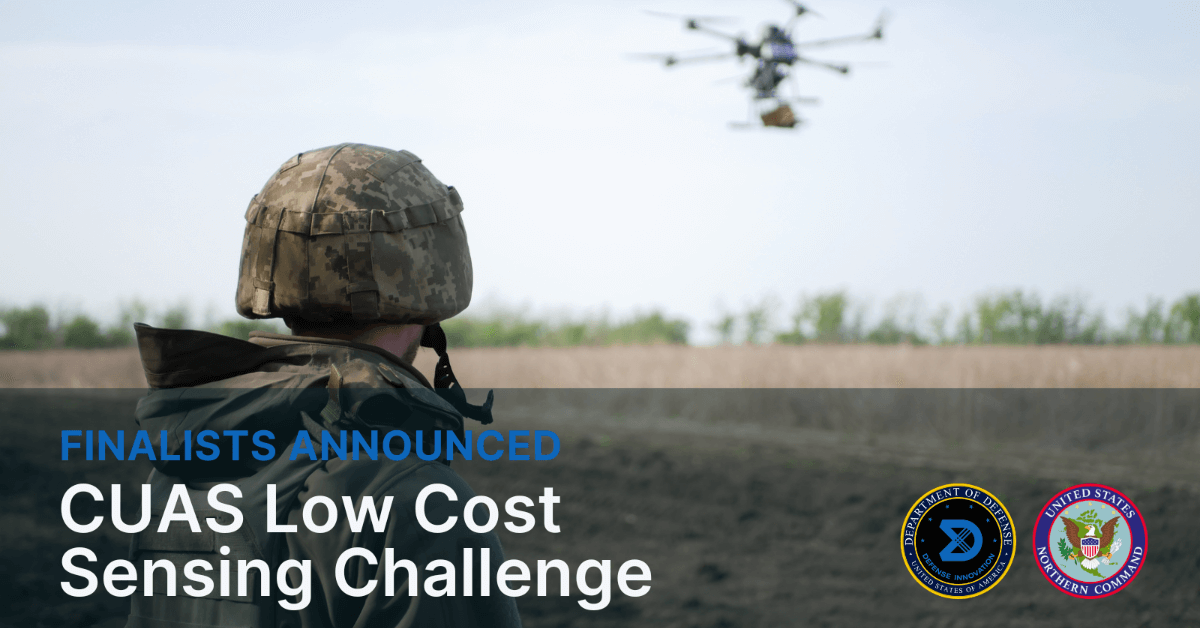10 companies advance scalable, cost-effective solutions to bolster U.S. counter-sUAS capabilities and meet evolving DOD strategic priorities
Washington, D.C., July 21, 2025 — The Defense Innovation Unit (DIU), in close collaboration with U.S. Northern Command (USNORTHCOM), U.S. Army, U.S. Navy, U.S. Marine Corps, and U.S. Indo-Pacific Command representatives, today announced the selection of ten finalists to advance in the Counter-small Unmanned Aircraft System (C-sUAS) Low-Cost Sensing (LCS) challenge. These selected companies, chosen against a rigorous set of criteria from 118 outstanding submissions, will move forward to demonstrate their sensor technologies during USNORTHCOM’s Falcon Peak exercise in September.
"The evolving threat from unmanned aerial systems demands that we leverage every tool at our disposal – from cutting-edge commercial solutions to robust partnerships across government and industry," said DIU Director Doug Beck. "This challenge directly supports DOD's strategic priorities by tapping into non-traditional defense companies to develop scalable, cost-effective sensing solutions that help our forces at home and abroad to identify threats with the speed and fidelity needed to counter them.”
The solutions selected represent a diverse range of sensor modalities, including radio frequency passive detection, active radar, acoustic, optical cameras, infrared cameras, and several mixed modality technologies. The selected approaches have the potential to deliver significant value compared to current DOD systems for key coverage areas, at a potential cost savings of 50-80 percent in total cost of ownership. The ten finalists selected are:
BLUEiQ
CHAOS 1
Fortem Technologies
Guardian RF
Hidden Level
MatrixSpace
REVOBEAM
Squarehead Technology
Teledyne FLIR Defense
Thalrix
Launched in May 2025, the LCS challenge was designed to address a critical need: to complement exquisite sensor systems with affordable, distributed sensing technologies that can scale. Protecting the homeland from small UAS threats requires broad situational awareness with reach, redundancy, and resiliency.
“These ten finalists represent the forefront of sensor innovation, demonstrating how diverse technological approaches can enhance our layered defense,” said Director of Replicator 2, David Payne. “Our collaboration with USNORTHCOM, the US Army, and other partners has been instrumental in aligning this effort with the Department’s most critical sensing needs. Ultimately, this prize challenge is about helping to provide the tools to extend cost-effective sensing capabilities to our most critical installations.”
Selected finalists now advance to live demonstration and testing at USNORTHCOM’s Falcon Peak 25.2 exercise. Falcon Peak will provide a real-world test of these low-cost sensing solutions and the prize purse will be distributed based on performance at the event.
Beyond the prize money, top performers may also be considered for follow-on opportunities, including Other Transaction (OT) agreements, a Cooperative Research and Development Agreement (CRADA), and direct transition into operational use, accelerating the deployment of these capabilities and making the best tech available to the warfighter with the speed and scale required.
